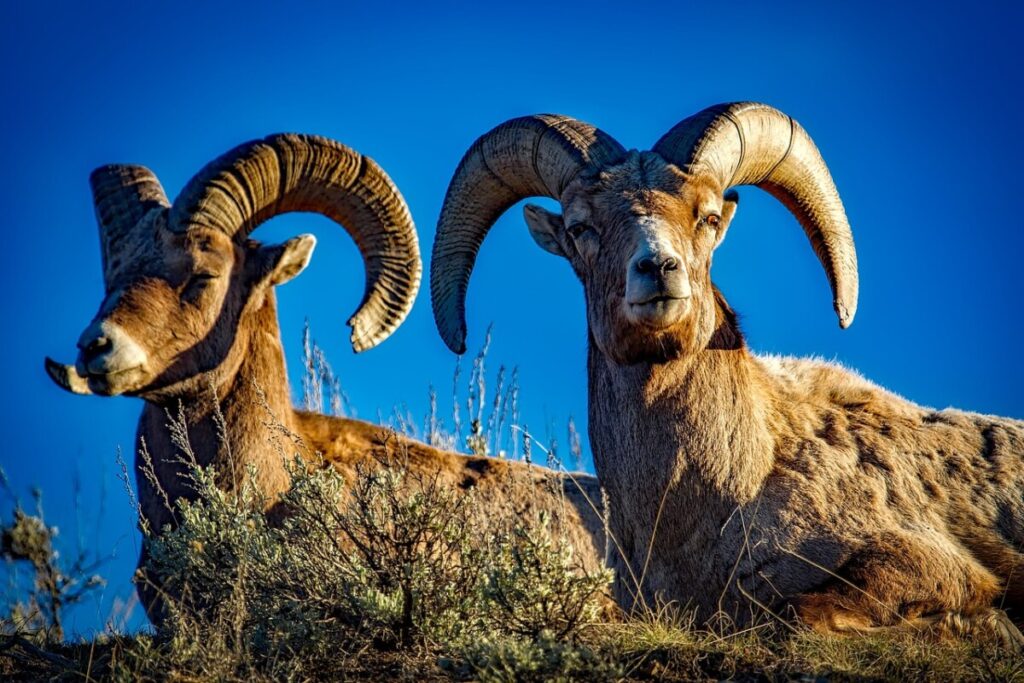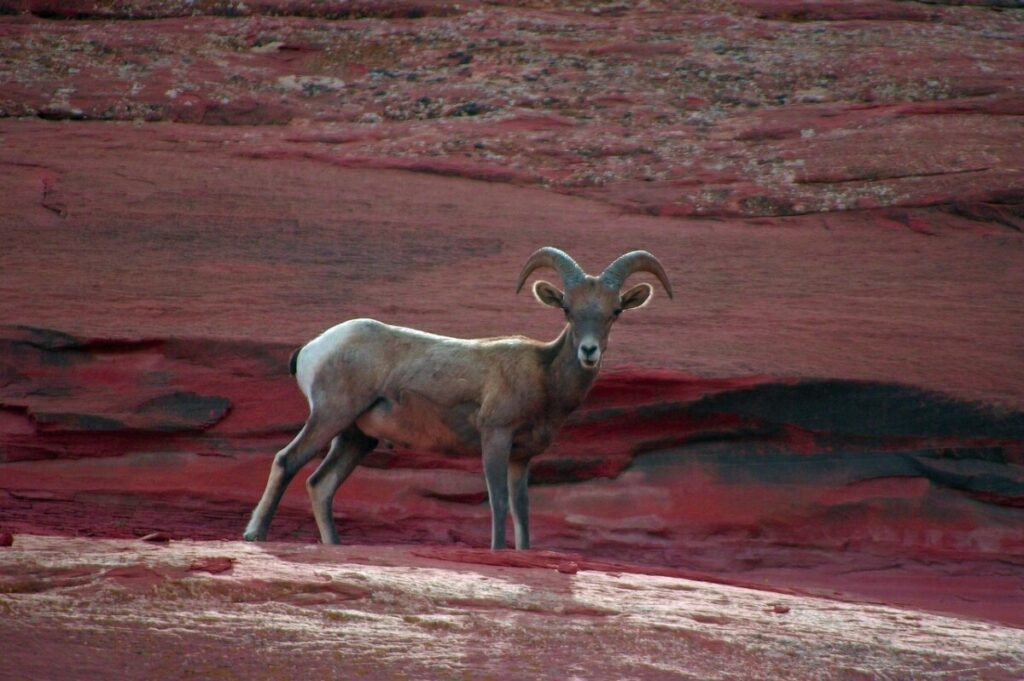Bighorn sheep (Ovis Canadensis)are a species of wild sheep found in North America. Their impressive horns and robust physique have made them an iconic symbol of the American West, drawing admiration from many observers. This article seeks to provide an overview of bighorn sheep biology, ecology, and conservation status.
The scientific name for bighorn sheep is Ovis canadensis; they belong to the order Artiodactyla and family Bovidae. They inhabit dry mountainous regions throughout western Canada and the United States, ranging as far north as Alaska and south into Mexico. Bighorns prefer open-forested areas that offer ample escape cover and grazing opportunities on grasses, herbs, lichens, shrubs, and other vegetation types.
A key feature of this species is its impressive horns which can reach up to three feet long in both males (rams) and females (ewes). These curved horns allow bighorns to defend against predators such as wolves or coyotes by butting heads with rivals during mating season battles.
The size of their horns also helps determine social rank within a herd’s hierarchy structure. The rest of this article will discuss how these behaviors impact population dynamics along with related topics such as habitat requirements and conservation efforts aimed at protecting this species’ future survival.

Species Of Bighorn Sheep
There are currently two recognized species of bighorn sheep: the Rocky Mountain bighorn sheep (Ovis canadensis) and the desert bighorn sheep (Ovis canadensis nelsoni). Both species are native to North America and are members of the Bovidae family.
The Rocky Mountain bighorn sheep is found in the mountainous regions of western North America, including the Rocky Mountains and surrounding areas. It has large, curled horns that are used for defense and for attracting mates.
The desert bighorn sheep is found in desert and mountainous regions of the southwestern United States and Mexico. It has a lighter-colored coat than the Rocky Mountain bighorn sheep and its horns are more curved and narrow.
Both species of bighorn sheep are important to the ecosystems in which they live, and they are prized game animals for hunters. They also face threats from habitat loss, disease, and human activity.
Discover 9 Fascinating Desert-Dwelling Animals
Habitat & Range Of The Bighorn Sheep
Bighorn sheep are a species of wild sheep that inhabit the mountains and prairies of North America. They have an expansive range across much of western Canada, as well as parts of northern Mexico, the United States, and even Alaska.
The habitat of bighorn sheep consists mainly of mountainous terrain with altitude ranges between 3,000 to 12,000 feet above sea level, usually in areas close to cliffs for protection from predators.
In terms of vegetation preference, these animals prefer grasslands, open woodlands consisting predominantly of conifers or evergreens such as Douglas-fir trees; however they will also feed on other types of shrubs and plants when available.
Bighorn sheep can often be found near water sources where they drink frequently throughout the day. In some regions their habitat overlaps with grazing lands used by domestic livestock so conflicts may arise due to competition for resources or diseases transmitted from one species to another.
The diet of bighorn sheep is largely herbivorous with a focus on grasses but it can also include lichens, mosses and sedges – depending on availability during different seasons. Foraging habits change seasonally based on what type vegetation is most abundant at any given time; in summer months they move upslope into alpine meadows while winter finds them moving downslope towards lower elevation habitats with more food options.
Alongside seasonal migrations which involve large groups travelling together in search of better quality grazing grounds, bighorn sheep also make use of smaller home ranges using local hillsides and valleys all year round.
Physical Characteristics Of The Bighorn Sheep
The Bighorn Sheep is a species of mountain-dwelling bovid, native to North America. It has several distinct physical characteristics that help it survive in its harsh environment.
One primary feature of the Bighorn Sheep is their horns, which can grow up to twice the size of the sheep’s head. The horns are composed of keratin and covered with a thick layer of fur, protecting them from damage over time.
They come in varying sizes depending on gender; males have larger, thicker horns than females, while female horns tend to be more curved or spiraled. In addition to serving as weapons for defense, they also serve as a form of identification among members of the same herd since no two sets are alike.
The body and legs of Bighorn Sheep are adapted for high-altitude living: they possess short but powerful muscles ideal for maneuvering through steep terrain quickly and efficiently.
Furthermore, they boast padded hooves designed specifically for gripping rocky surfaces; these enable them to move easily across slippery surfaces or climb vertical cliffs without slipping or losing balance. While most sheep are white in coloration, many individuals may have brownish coats instead; this helps camouflage them against predators when necessary.
Bighorn Sheep have evolved various mechanisms by which they can successfully inhabit some of the harshest habitats found in nature today. From their horns used for defense and recognition purposes, to their specialized musculature and hooves enabling mobility even on difficult terrain – these animals exhibit an impressive array of adaptations that allow them to thrive under extreme conditions.
Diet & Foraging Habits Of The Bighorn Sheep
The diet of the Bighorn Sheep varies depending on their location and season. Typically, they feed on a variety of grasses, sedges, herbs, and shrubs that are available in mountain regions.
During winter, they will migrate to lower altitudes where there is more food available; here they primarily consume woody plants such as sagebrush and other low-growing vegetation. Additionally, during spring and summer months, these animals also eat different types of fruits from nearby trees or bushes.
Foraging behavior for this species consists mainly of grazing but can include browsing as well. They are able to reach faraway sources of food by climbing steep slopes with ease due to their strong hooves which provide good traction on slippery surfaces.
This allows them to access areas with more nutrition than what would be found at ground level. As a result of their highly specialized adaptations for accessing distant food sources, bighorn sheep have been known to roam very large territories (up to 20 miles).
Bighorn sheep exhibit a wide range of dietary needs throughout the year in order to maintain healthy body condition and reproductive success. Their diet includes various wild flowers and leaves along with bark from certain tree species when necessary – all optimized for providing maximum energy intake while expending minimal energy in search efforts.
Consequently, this has enabled them to thrive in some of the most extreme climatic conditions found within mountainous regions across North America.
Breeding & Reproduction Of The Bighorn Sheep
Bighorn sheep reproduce through a system known as polygynous mating which involves one male and multiple females. Breeding occurs typically in the fall with rutting season taking place between November and December.
During this time, males will compete for dominance to gain access to female mates by engaging in head-butting contests. The dominant ram (male) will then mate with all of the ewes (females) from his harem leading up until March when lambing takes place.
The survival rate of lambs is higher if they are born earlier in the year, making it beneficial for them to be conceived during late fall or early winter. Lambs reach sexual maturity at an age of just over 1 year old and can start breeding shortly after that. In addition, bighorn sheep have been found to live up to 11 years in the wild while some individuals have lived even longer than 15 years under captive conditions.
Lambs may stay with their mothers for protection but eventually leave her group when they become sexually mature. Females may join other groups depending on availability while males tend to roam alone until they find another herd or establish their own harem with young females who were kicked out from their previous herds due to competition from older males.
Behavior & Social Structure Of The Bighorn Sheep
The behavior and social structure of the bighorn sheep is an important part of their existence. Bighorn sheep are typically found in herds, which can range from a few dozen to more than one hundred individuals.
They form different types of groups depending on the season; males tend to gather together during rutting season while females will stay with their young or join other female herds. During non-rutting seasons, they may congregate into larger mixed-gender herds or break off into smaller groups.
Bighorn sheep demonstrate great agility when navigating terrain, using their hooves as well as their horns to climb steep cliffs and rocky surfaces. This allows them better access to food sources that would otherwise be difficult for them to reach due to predators or environmental obstacles.
In addition, these animals exhibit strong forms of communication such as body language and vocalizations that help maintain order within herd dynamics and aid in avoiding potential danger from predators.
Herd members have dominance hierarchies based on age and sex; older males generally dominate younger ones, and adult rams usually outrank ewes if there’s competition over resources like food or water.
These social structures also allow for cooperative behaviors among flock members including shared grazing areas and protection against external threats — each individual contributes by keeping watch for predators or warning fellow members about potential dangers.

Threats To The Bighorn Sheep Population
The threats to the bighorn sheep population are numerous and must be addressed to ensure their continued survival. Habitat destruction is one of the primary reasons for decreased populations in certain areas, as humans encroach upon land that was previously available for them to roam.
In addition, overgrazing by domestic livestock can lead to competition with wild animals such as bighorn sheep and reduce the available resources they require to survive. Disease transmission from domestic animals to wild species is also a concern; this could include diseases like respiratory infections or parasites which can have devastating effects on a herd’s health.
Climate change has been identified as another factor contributing to declining numbers of these animals in some parts of the world. Warmer temperatures and increased precipitation levels can cause changes in vegetation availability or other habitat features, leading to further stressors for these creatures who depend on specific conditions for optimal survival.
Additionally, human-induced mortality through hunting and poaching continues to take its toll on wildlife populations around the globe, including those of bighorn sheep.
It is evident that if we hope to conserve bighorn sheep populations into the future, action needs to be taken now. Protecting and restoring natural habitats, limiting access by humans when necessary, preventing disease transmission between domestic and wild animals, controlling hunting/poaching activities where appropriate.
All of these measures will help sustain healthy herds of bighorn sheep across their range. However, without concerted efforts at local, regional, national and international levels there may not be enough being done soon enough before it is too late for many endangered species around the world.
Conservation Efforts To Protect The Bighorn Sheep
The conservation of bighorn sheep is an important focus for the preservation of their population. In order to protect the species, there are a number of strategies that have been employed and developed. These efforts aim to ensure the safety and longevity of this species in its natural environment.
One such effort involves increasing awareness among local people about the threats posed to bighorn sheep populations. This includes educating locals on topics such as habitat destruction and poaching, which can cause irreparable damage if left unchecked.
Additionally, government agencies have attempted to promote responsible hunting practices in areas with bighorn sheep populations, thereby minimizing illegal activity. Furthermore, certain organizations have also worked towards developing environmental policies that would benefit these animals from a legislative standpoint.
In addition, research has also been conducted into ways in which habitats could be managed more efficiently so as to provide optimal conditions for bighorns to thrive within them. Various techniques such as fencing off key habitats or creating predator-free zones may prove useful in boosting population numbers over time.
Moreover, some organizations have even taken steps to reintroduce captive-bred individuals back into wild environments through translocation programs. All these measures are aimed at preserving existing bighorn populations while simultaneously providing greater protection against future declines due to human interference or other factors.
